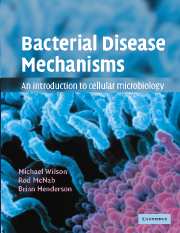Book contents
- Frontmatter
- Contents
- Preface
- Abbreviations used
- Chapter 1 An introduction to bacterial diseases
- Chapter 2 Bacterial cell biology
- Chapter 3 Molecular analysis of bacterial virulence mechanisms
- Chapter 4 Communication in infection
- Chapter 5 The mucosal surface: the front line of antibacterial defence
- Chapter 6 Immune defences against bacteria
- Chapter 7 Bacterial adhesion as a virulence mechanism
- Chapter 8 Bacterial invasion as a virulence mechanism
- Chapter 9 Bacterial exotoxins
- Chapter 10 Bacterial evasion of host defence mechanisms
- Chapter 11 Bacteria in human health and disease: the future?
- Appendix A Glossary of terms used
- Appendix B Brief descriptions of bacteria frequently mentioned
- Index
- Plate section
Chapter 11 - Bacteria in human health and disease: the future?
Published online by Cambridge University Press: 05 June 2012
- Frontmatter
- Contents
- Preface
- Abbreviations used
- Chapter 1 An introduction to bacterial diseases
- Chapter 2 Bacterial cell biology
- Chapter 3 Molecular analysis of bacterial virulence mechanisms
- Chapter 4 Communication in infection
- Chapter 5 The mucosal surface: the front line of antibacterial defence
- Chapter 6 Immune defences against bacteria
- Chapter 7 Bacterial adhesion as a virulence mechanism
- Chapter 8 Bacterial invasion as a virulence mechanism
- Chapter 9 Bacterial exotoxins
- Chapter 10 Bacterial evasion of host defence mechanisms
- Chapter 11 Bacteria in human health and disease: the future?
- Appendix A Glossary of terms used
- Appendix B Brief descriptions of bacteria frequently mentioned
- Index
- Plate section
Summary
Aims
To provide the reader with a glimpse into the future with regard to:
new approaches to studying bacterial pathogenesis
the development of new methods of treating diseases caused by bacteria
the involvement of bacteria in human diseases of unknown causation
the role of the normal microflora in human development
Introduction
The 1950s and 60s heralded what was assumed to be the pinnacle of our control over bacterial diseases. Antibiotics could treat most bacterial infections, and, in time, would treat all bacterial infections, and that was all there was to it. If you could eradicate the bacterium, why bother understanding how it caused disease? While there was a certain logic to this viewpoint, it went against our fundamental human need to understand how things work. In retrospect, it also slowed down progress in our understanding of the workings of the cell and of immunity. The renaissance in the study of the biology of bacteria, which has been forced upon us by the rapid rise in antibiotic resistance and the discovery of ‘new’ bacterial diseases, has revealed a whole new world of cellular interactions between prokaryotes and eukaryotes, and between prokaryotes and prokaryotes, that were undreamed of only 10 to 20 years ago. The rapid progress in Cellular and Molecular Microbiology made in the past 10 to 15 years suggests that the next decade will see major advances in our understanding of the cellular and molecular microbiology of prokaryotic/eukaryotic interactions. Our final chapter aims to give an insight into what the reader may expect to see in this period.
- Type
- Chapter
- Information
- Bacterial Disease MechanismsAn Introduction to Cellular Microbiology, pp. 583 - 614Publisher: Cambridge University PressPrint publication year: 2002



